Navigating Through Disruption: A Pharma 50 View
Outlining the new leadership and C-level roles of tomorrow needed to take on the disruption event on pharma's horizon.
Russell Reynolds Associates outlines the new leadership tactics and C-level specialty roles that Pharma 50 companies will need to steer the industry through the disruptive event on its horizon.
The pharma business model is still largely a traditional model characterized by a simple formula: One product. One customer. One price. The model has been viable for decades and has brought high returns to the industry. Since the 2000s, however, the stakeholder map has become more complex, as purchasing power has been shifting from physicians to payers, regulatory bodies and, to some extent, patients. We believe this shift will eventually lead to a significant event in the industry that will disrupt how companies price their products and require a different type of leadership in the industry.
In Earth’s history, 66 million years ago, a meteoric disruption-known as the K-T event -led to the extinction of several large species. After the event, dinosaurs became extinct while more nimble and adaptive small reptiles, birds and mammals survived. Is a similar event coming for the pharma industry? We believe a P-E (pharmaco-economic) event will occur, where the US government institutes legislation requiring demonstrated product outcome and prices based on patient value. In this case, the concepts of product, customer, and price are redefined. In the post P-E event era, the industry will be governed by brand new rules, which will require pharma companies to adapt to avoid going the way of the dinosaur. The old model of single-pill solutions and lifecycle management to drive innovation will give way to more agile companies that are driving whole-patient, or “beyond-the-pill,” services and novel therapies.
This changed business environment will also require a new set of leaders that are patient-centric driven, have greater content and scientific expertise, and can understand insights from the vast amount of real-world data generated by products in the market. In order to navigate through this upcoming disruption, we believe pharma companies are already creating new roles and seeking new types of leaders to guide the transformation and adapt to the change.
In our proprietary research, Russell Reynolds Associates (RRA) has examined the new C-level positions (CxO) across the top-50 pharma companies for patterns and trends and developed an outlook for the near future. In this article, we offer a perspective on pharma leadership through two lenses:
- Changes in pharma leadership to date. In reaction to stricter regulatory requirements, we observe the emergence of specialist roles and their elevation to the C-level.
- The next horizon of pharma leadership. In preparation for a P-E event, we expect an emergence of new leaders, whose goal will be to guide the industry through continued disruption.
In our analysis, we considered the composition of executive management committees and extended senior management teams, including CEOs and their direct reports, for top-50 pharma companies. The research was conducted using publicly available information from May 2017, such as company websites, BoardEx, and LinkedIn, and was supported by RRA’s ongoing consulting to the pharma industry.
Traditional managers to C-suite specialists
In the 1990s, the executive committees of large pharma companies started to grow in size. Geographic expansion, regulatory complexity in established and emerging markets, and diversification of market portfolio and assets in the R&D pipeline are just some factors that led to the rise of specialists in certain therapeutic areas, geographies, R&D stages, and corporate functions-all with a seat at the C-table. The organizations grew into large and complex matrix organizations.
Today, the average size of the senior leadership team at top-50 pharma companies is 11-12 members, and the range varies widely from four to 28. Among top-50 organizations, 58% have business unit heads in their C-family, on average two to three, and a maximum of eight. Conversely, regional heads have started to disappear from leadership’s inner circle, and today only one out of three top-50 pharma firms has regional heads at the very top (see Figure 1; click to enlarge).
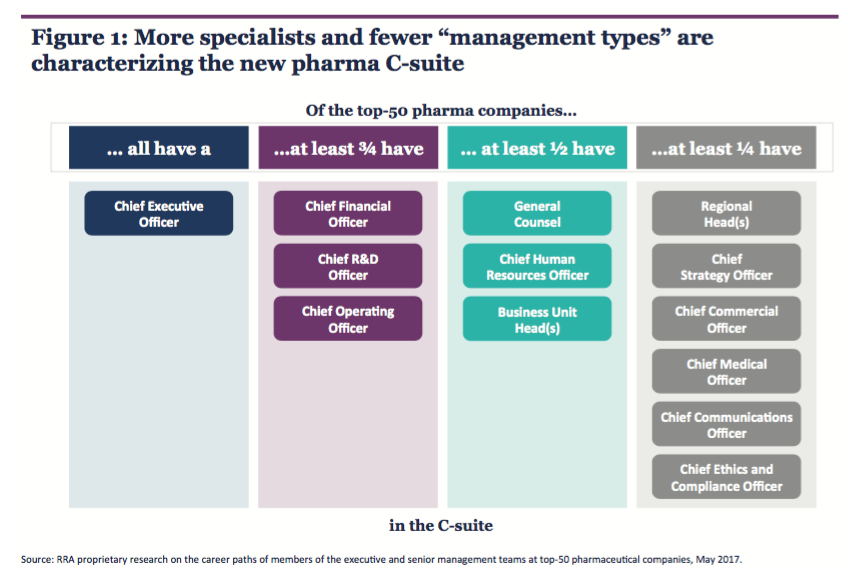
In the 2000s, with regulatory requirements becoming more stringent, a number of specialist position were elevated to the C-suite, replacing traditional managers. Specifically, we see three roles that have extended their remit significantly and have been elevated to the C-level in many pharma organizations.
Chief Medical Officer. Traditionally rooted in the R&D organization, the medical affairs function has evolved dramatically in recent years, driven by regulatory scrutiny and operational complexity. Today, medical affairs fulfills a strategic mandate to represent “the voice of the patient” internally vis-à-vis R&D, commercial, and other functions and to drive high value-add activities externally. In 28% of top-50 pharma companies, the Chief Medical Officer reports directly to the CEO and has a prominent external-facing role. For the purpose of this study, we analyzed the background of Chief Medical Officers in pharma C-suites in terms of education and previous professional experience. Our analysis suggests that scientific rigor and previous extensive experience in R&D, medical affairs, and/or regulatory affairs helps increase credibility, independence and authority internally as a patient advocate and externally as the primary medical representative of the company in the market (see Figure 2). Additional experience in commercial or project-related activities complements the profile of a Chief Medical Officer and sharpens his/her strategic focus.
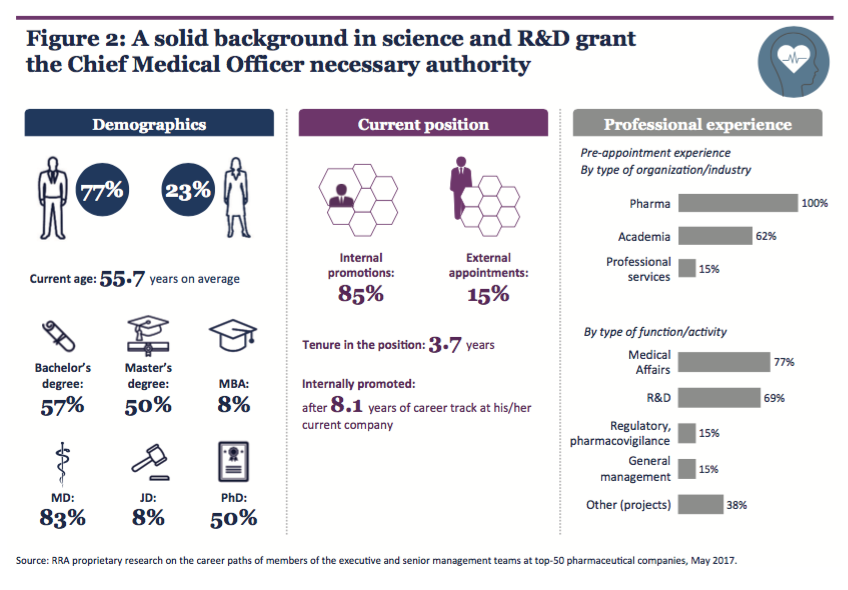
Chief Ethics and Compliance Officer. Recent challenges in the pharma market-sales and marketing malpractice, off-label sales, and data integrity, among others-have led to legal issues and shaped negative public opinion about pharma companies. Going forward, the pharma industry needs to (re-)position itself as a trusted partner in public health. To ensure regulatory and non-regulatory compliance and ethical behavior and find new ways to engage with prescribers, key opinion leaders, and other external stakeholders, pharma organizations are taking an integrated approach to compliance.
Twenty-six percent of top-50 pharma companies have elevated the Chief Ethics and Compliance Officer to a direct report to the CEO or the Board. To spot potential issues before they emerge, the Chief Ethics and Compliance Officer assesses the value chain for the possibility of behaviors that violate ethical or regulatory mandates. To set a course of right behavior from the start, the Chief Ethics and Compliance Officer also serves as a key advisor on the adoption of business models and the assessment of transformation risks.
A more detailed look at the profile of Chief Ethics and Compliance Officers leads to the conclusion that a solid legal background and an extensive track record in the pharma industry are prerequisites for the role. A high ratio of internal promotions from deputy General Counsel or divisional legal business partner within the same organization suggests that credibility and trust on the side of business leaders as well as internal connections are essential to get buy-in for this role (see Figure 3).
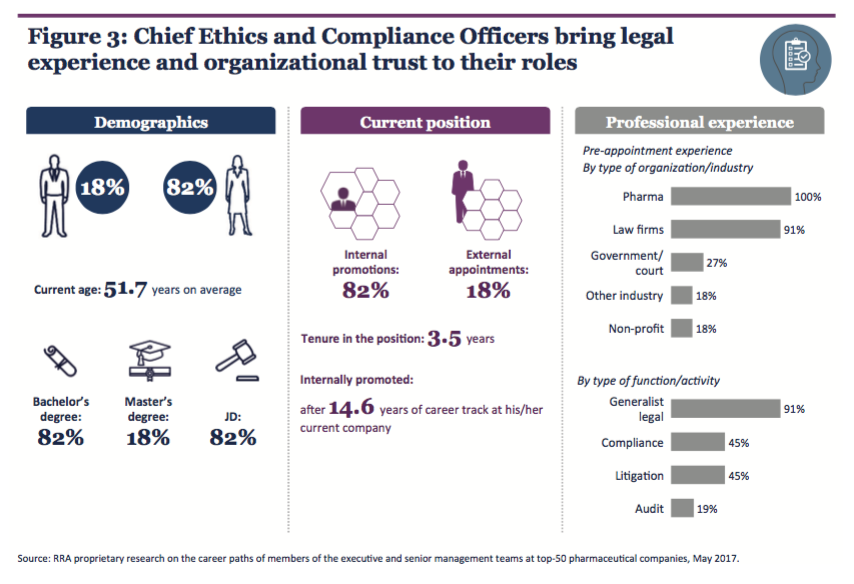
Chief Quality Officer. Over the last decades, the pharma industry has grown tremendously in size and complexity and developed a highly sophisticated system to ensure that patients receive high-quality products. Most pharma companies have been undergoing the transformation process from baseline compliance and delivery on regulatory authority inspections to continuous improvement and a culture of quality, or speaking in their lingo, from quality control to quality assurance. To complete the organizational separation of quality from operations on a corporate level, 24% of companies have elevated the Chief Quality Officer to the level of direct report to the CEO.
A route-to-the-top analysis indicates that this is a narrow field of specialization, as the vast majority comes through internal promotions from within the pharma company’s quality function, by having their roots in quality (83%) and/or technical laboratory analysis (50%) (see Figure 4). The fact that at the very top, quality is occasionally co-located with other responsibilities, for instance, HSE (health, safety, and environment) explains the broader range of other experiences.
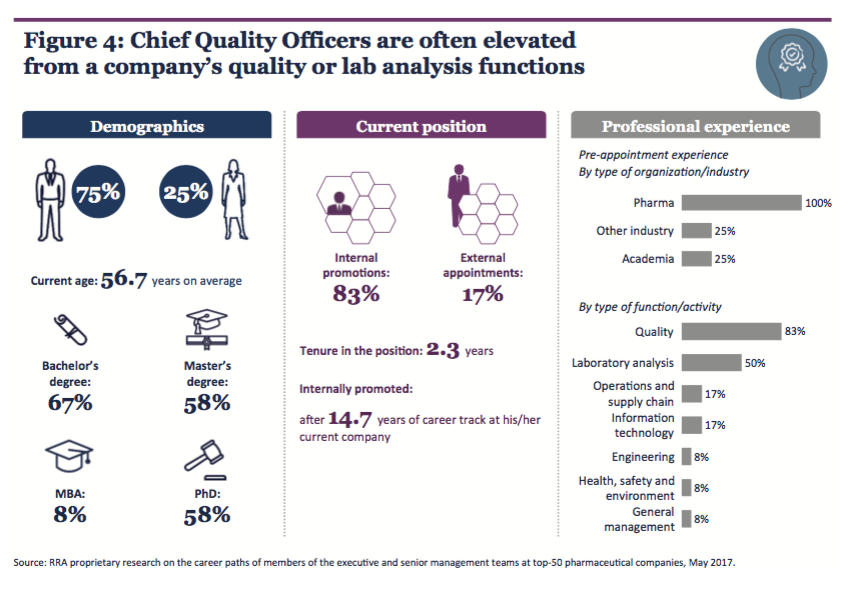
A bolder future of transformation
The roles described have been evolving over time, but companies may decide to shift from this incremental approach to more aggressive leadership development in preparation for a P-E event. The goal is to provoke and accelerate change bold enough to help the organization adapt to the quickly changing ecosystem while recognizing that the specific type and pace of change should be calibrated to the company’s starting point regarding process and cultural maturity.
This change will involve institutionalizing new roles across three categories: transformation leaders, ecosystem leaders, and enabling leaders.
Transformation leaders
The leaders in this first category are the architects, motivators, and catalysts that help pharma companies adapt and grow into organizations that can meet the challenges of a new industry landscape.
Chief Transformation Officer. Chief Transformation Officers have a mandate to lead the organization through momentous times in a company’s history. Effective Chief Transformation Officers inspire employees and act as role models for the sort of behavior needed to encourage and embed change. To be able to orchestrate a highly complex process and deliver on results, they need the full support of the Board, the CEO, and the entire executive team. Among the companies in the top-50 pharma ranking, only two have already nominated top executives to lead the transformation-Alexion and Amgen. Given a very limited sample size, we can give only a directional profile of a Chief Transformation Officer: well-regarded senior executive with previous experience in transformational processes at larger organizations outside the pharma sector, excellent problem solving skills, and very strong interpersonal skills.
Chief Digital Officer. Digitization of the pharma industry has a strong impact on all functions along the value chain. To reap the benefits of digital, pharma companies must plan for, build, and operationalize their digital capabilities, often into evolving business functions. To accelerate the process, a Chief Digital Officer often acts as a catalyst with a mandate to drive digital transformation, challenge the corporate thinking on digital, and define the digital strategy across all corporate functions. The ultimate goal is, however, to evolve to a digitally integrated organization and develop a generation of digitally savvy business leaders in all functions.
Chief Data Officer. Big data has the potential to revolutionize the industry, though complexity within the regulatory environment and pharma business model are two main reasons why the large pharma companies are still lagging behind in adoption of advanced analytics. In addition to the fact that ownership of post-clinical data is not in the hands of the pharma industry, the key challenge for most companies is how to translate all the innovative ideas into something tangible and “real.” The mandate of a Chief Data Officer would be to build the governance process and lifecycle management for big data and define where the most value can be created-i.e., translate the insights from advanced analytics into commercial impact and real financial outcome. Transformation requires the Chief Data Officer to be a change agent with an understanding of relevant data sources, technology and tools, and data science as well as strong business acumen and excellent communication skills.
While each leadership position described so far is distinct in its set of responsibilities, they require a shared set of attributes. In RRA’s proprietary analysis conducted in 2015, we distilled the core competencies of effective transformation leaders and found that the most successful leaders embody five specific characteristics (see Figure 5).

First, they are innovative, with a propensity to challenge traditional methods and approach matters in new ways. Second, they are disruptive, willing to take calculated risks and “buck the system” when necessary. Third, they are decisive leaders who boldly carry the torch of change. Fourth, they are socially adept leaders with the ability to understand people and easily adapt to different audiences. Fifth, transformation leaders are determined-a characteristic evident in their high level of optimism and their achievement orientation.
Ecosystem leaders
We are beginning to see many roles emerging with a shared goal-to manage the relationships with the external world-we call them “ecosystem roles.” These roles help pharma companies proactively shape their own positioning in the ecosystem vis-à-vis other players, build long-lasting partnerships as well as create and effectively communicate value of pharma products and services. The end goal is improved health outcomes, faster time-to-market for products, and more efficient management of internal and external R&D processes.
The roles that are beginning to emerge to help manage these partnerships are largely situated at the middle-management level and have a mandate to align different (and “siloed”) functions within the pharma organization to deliver consistent messages to the external world (see Figure 6). In order to break through the organizational barriers and ensure the right level of focus and investment, 30% of companies have introduced one or more ecosystem roles into their C-families, ensuring that their objectives are given high priority, top-level backing, and sufficient resources.
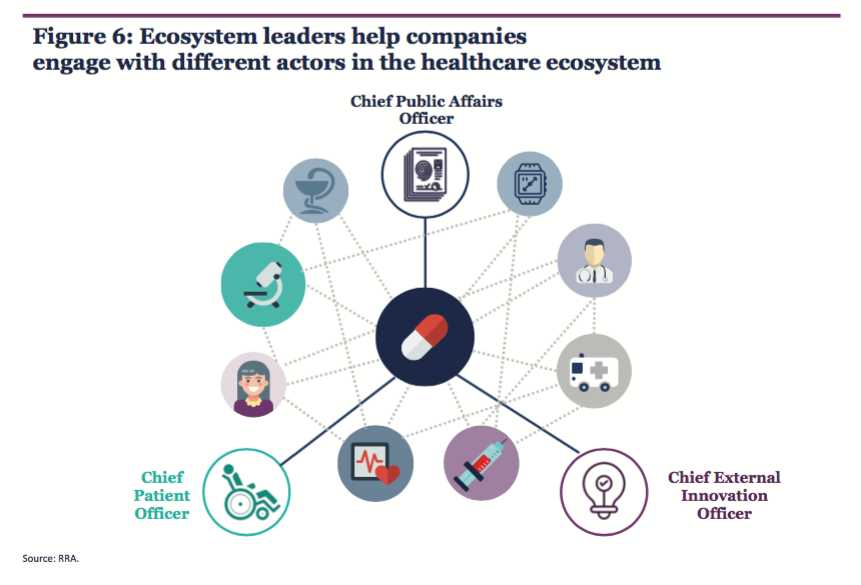
To deal with different players in the healthcare ecosystem, we see several emerging archetypes of positions.
Chief Patient Officer. To reflect the shift to a more patient-centric business model, pharma companies are introducing roles that take a holistic view and think through the entire patient experience. Roles like Head of Patient Journey Excellence, Head of Patient Experience, and Head of Patient Engagement are seen more in the health services space but have begun to appear in pharma as well. In 2012, UCB was the first top-50 pharma company to appoint a Chief Patient Affairs Officer, followed by Sanofi in 2014. Today, Merck & Co. is the only company among the top 50 with a Chief Patient Officer in the C-suite. The primary goal of the position is to bridge the gap between the patient community and the pharma company-and more broadly, the pharma industry.
Chief Public Affairs Officer. Being traditionally a communications function, this role has evolved over time. Today, it covers strategic communication, government relations, public policy, health policy, investor relations, and more. Among top-50 pharma companies, 25% have a more traditional communications, corporate affairs, and corporate social responsibility seat in the C-suite, and another 25% have extended the role or created an additional one for engagement with external stakeholders (external affairs, public affairs, and global government affairs are the common titles).
Chief External Innovation Officer. Approximately 75% of the most exciting late-stage assets in the collective pharma industry pipeline comes from sources outside of the company that owns them today. The traditional sourcing routes have been in-licensing, corporate acquisition and R&D collaboration. This spectrum has been expanded by new models of engagement with external innovators such as open innovation models, corporate ventures and direct company engagements. In order to effectively manage diversity and the complexity of externally sourced innovations, companies require a more strategic and orchestrated approach. Today, 18% of top-50 pharma companies have a business development leader at their C-table. Other companies have introduced new roles; for instance, Roche has a Head of Partnering in its enlarged corporate executive team, and Abbott has a Head of Ventures in its leadership team. As external innovation and business/corporate development are increasingly becoming synonymous with each other, it is only a matter of time until we see the first Chief External Innovation Officer.
Enabling leaders
In the pharma industry, permanent restructuring, post-acquisition reorganization, cost-cutting initiatives and similar internal disruptions can have two potentially dangerous but highly manageable byproducts: organizational fatigue and burdensome administrative complexity. Two groups of enabling leaders can address these issues, providing the high levels of ongoing support that create an organizational environment that is able to sustain sizable transformation.
People and culture leaders. We can expect new C-suite roles to be created to promote people, culture, well-being, and inclusiveness. In addition to Chief People Officers, we will see more Chief Diversity and Inclusion Officers and Chief Culture Officers at the very top of the leadership ladder-with the mission to actively shape and promote internal company culture and foster employee happiness and satisfaction.
Productivity and efficiency leaders. To address the inevitability of larger leadership teams and more complex organizational structures, we observe the desire to consolidate and even centralize some responsibilities on a corporate level and/or vertically throughout the organization. An example of consolidation is the role of a Chief Administration Officer (6% of top-50 companies). This person assumes the administrative back-office accountability and relieves the CEO from his/her day-to-day tasks, allowing him/her to put extra time and effort toward more strategic and critical decisions. An example of centralizing the larger number of administrative responsibilities is placing one person on the senior management team in charge of global business services (6% of top-50 companies). This role is in charge of business support services and can be considered as a “span breaker,” i.e., productivity and efficiency gain for the entire global organization.
Considerations and lessons learned
In anticipation of a P-E event, we expect pharmaceutical companies will consider new roles-transformation, ecosystem, or enabling-as a part of their leadership teams. In order to design these roles-and set the leaders in these roles up for success-companies need to think critically and honestly about their unique needs and leadership goals, the full shape of prospective positions and where they are today in the transformation journey (see Figure 7).
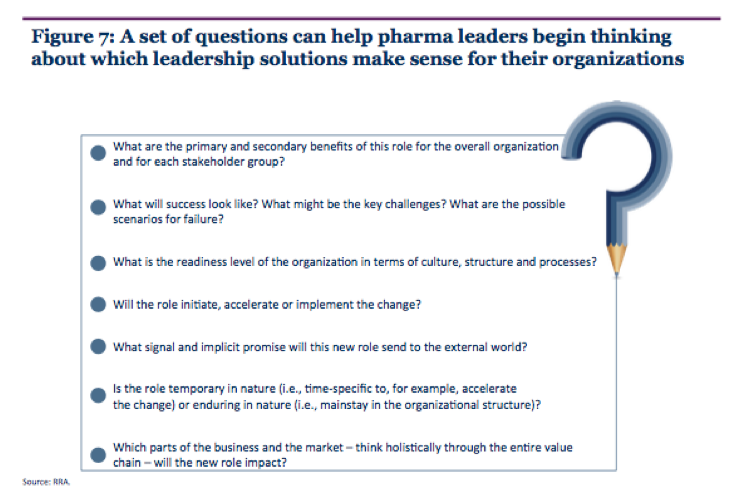
While the C-suite changes are just now beginning in pharma, other industries have already progressed in their leadership adjustment. In the consumer goods industry, for example, we have already seen a higher number and an increased diversity of new CxO roles, such as Chief Growth Officer, Chief Customer Officer and Chief Omnichannel Officer. The Chief Design Officer in automotive and the Chief Innovation Officer and Chief Customer Experience Officer in health services are examples of new specialist positions institutionalized at the highest levels of the organization. The pharma industry can learn from these examples and try to break down functional barriers and align the company.
The key learnings from other industries are the following:
The right leader is key. The success of these new roles is dependent on finding someone who embraces the change and confidently leads the transformation. Identifying the best talent either internal or external to the organization, who has transformation competencies, is critical.
Cultural collision is inevitable, so be prepared. As the mandate of a new leader is to challenge the status quo, some degree of conflict is predetermined. In the case of externally appointed leaders, the Board and CEO need to effectively onboard new leaders to minimize cultural conflicts while pushing for the change.
Success must be measurable. A clear set of key performance indicators to measure success of the new roles allows leadership to further refine the role itself and its scope of responsibilities, as well as ensure an appropriate level of dedicated resources.
Monitoring adaptations in organizational structures, both within the industry and outside, will give a clue to how imminent leaders believe this change will happen. Within the healthcare industry, emerging biotech and digital health companies will likely move faster along these future trends, and it may take time for these roles to trickle up to larger more established organizations.
The quickening pace of change in the industry will require a bold reimagining of top-level leadership to adjust and thrive in a new pharma environment that emphasizes demonstrated product outcomes and value to patient. The transformation approach may vary by organization, but all the companies will need to adapt to the change eventually.


Waseem Noor is a Consultant at Russell Reynolds Associates. He can be reached at waseem.noor@russellreynolds.com
Saule Serikova is Global Knowledge Leader for Healthcare at Russell Reynolds Associates. She can be reached at saule.serikova@russellreynolds.com

2 Commerce Drive
Cranbury, NJ 08512
All rights reserved.